Garces Gatnau Joan Ramón
Therapy is carried out in three stages:
- Application of the substance in the form of a cream
The photosensitizer is applied in the form of a cream to the area to be treated, which has already been prepared to facilitate absorption. Before the cream is applied, the dermatologist removes the outer layers of skin. Once the cream has been applied, the area is covered with a special dressing to prevent evaporation and to assist absorption, as well as protecting it against exposure to sunlight.
This stage is completely painless and requires no anesthetic. Application of the cream may produce a slight sensation of soreness that disappears after a few minutes.
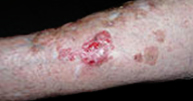 Superficial carcinoma lesiona on a leg Superficial carcinoma lesiona on a leg |
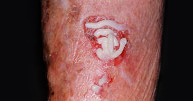 Applications of the cream Applications of the cream |
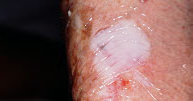 Occlusion to increase absorption Occlusion to increase absorption |
- Waiting time
The time required for occlusion is known as the incubation period and normally lasts for three hours. Throughout this time the patient is able to behave as normal but must avoid direct exposure to sunlight on the affected area. The special dressing is designed to protect this area. When the photosensitizer has been absorbed into the tissue it gives off a coral red fluorescence under a Wood's lamp (black light). This indicates the density and extent of absorption.
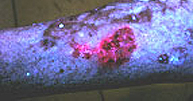
Coral red fluorescence from the above lesion
- Illumination (the therapy itself)
The next stage is illumination in order to bring about the selective destruction of the cells that have taken up the photosensitizer. The surrounding cells (which have not absorbed the cream) are not destroyed, although they are illuminated with the same intensity for the same period of time.
The types of light used for illumination may vary (laser, xenon, incandescent, LED), but they must oscillate between 410 nm (maximum absorption) and 630 nm (maximum penetration), while the total amount emitted should be between 37 and 150 J/cm2. In our particular case – the treatment of precancerous or cancerous skin lesions - we normally use a red light with a wavelength of about 630 nm, since it is important for the light to penetrate as deeply as possible.
Illumination time lasts for approximately 10 minutes altogether. This time may be slightly longer in some cases, since the light may be applied discontinuously (with pauses in between) until the required amount is obtained.
This stage may occasion a pain with a burning sensation that may be intense over extensive areas and therefore require a local anesthetic. Both the extension and sensitivity to reception as well as the type of skin normally indicate the possibility of pain due to illumination. In these cases the dermatologist administers the anesthetic at the start of the session. Nevertheless, the great majority of lesions require no type of anesthetic.
Two sessions over a period of a few weeks are normally required to achieve the best results. However, the treatment may be repeated as many times as necessary without affecting healthy tissue, since only damaged tissue is destroyed.
Recent advances have enabled waiting times to be reduced, and the treatment process as a whole can now be performed more quickly.
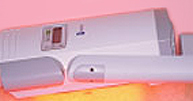 Illumination of a leg with a LED lamp Illumination of a leg with a LED lamp |
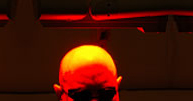 The eyes are protected with The eyes are protected withspecial glasses during illumination |
| Morning | Afternoon | |
|---|---|---|
| Monday | 9.00 - 15.00 h | 15.00 - 20.00 h |
| Tuesday | 9.00 - 15.00 h | 15.00 - 20.00 h |
| Wednesday | 9.00 - 15.00 h | 15.00 - 20.00 h |
| Thursday | 9.00 - 15.00 h | 15.00 - 20.00 h |
| Friday | 9.00 - 15.00 h | 15.00 - 20.00 h |















